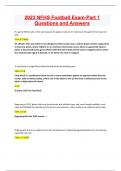Contents
Table of Contents
Specification ......................................................................................................................................... 2-4
Transition Metals .....................................................................................................................................5
General Properties of Transition Metals .................................................................................................................................................. 5
Transition Metal Complexes ................................................................................................................. 6-8
Complex Ions ........................................................................................................................................................................................................ 6
Ligands .................................................................................................................................................................................................................... 7
Shapes of Complex Ions ................................................................................................................................................................................... 8
Substitution Reactions .........................................................................................................................9-10
Substitution Reactions .............................................................................................................................................................................. 9-10
Formation of Coloured Ions ............................................................................................................... 11-12
Formation of Coloured Ions ................................................................................................................................................................. 11-12
Variable Oxidation States .................................................................................................................. 13-15
Variable Oxidation States............................................................................................................................................................................. 13
Silver ..................................................................................................................................................................................................................... 14
Manganate Redox Titrations ...................................................................................................................................................................... 15
Catalysts ............................................................................................................................................ 16-18
Heterogeneous Catalysts....................................................................................................................................................................... 16-17
Contact Process .................................................................................................................................................................................................. 17
Homogeneous Catalysts ........................................................................................................................................................................ 17-18
Reaction Between Iodide Ions and Persulfate Ions............................................................................................................................. 18
Autocatalytic Reaction Between Ethanedioate Ions and Manganate Ions .............................................................................. 18
Metal-Aqua Ions ................................................................................................................................ 19-22
Metal-Aqua Ions ........................................................................................................................................................................................ 19-22
Action of NaOH ............................................................................................................................................................................................ 19-20
Action of NH3 ....................................................................................................................................................................................................... 20
Action of Na2CO3 ................................................................................................................................................................................................ 20
Colours and Precipitates ......................................................................................................................................................................... 21-22
1
,Specification
General Properties of Transition Metals
Content:
• Transition metal characteristics of elements Ti–Cu arise from an incomplete d sub-level in atoms or
ions.
• The characteristic properties include:
o Complex formation
o Formation of coloured ions
o Variable oxidation state
o Catalytic activity
• A ligand is a molecule or ion that forms a co-ordinate bond with a transition metal by donating a pair
of electrons.
• A complex is a central metal atom or ion surrounded by ligands.
• Co-ordination number is number of co-ordinate bonds to the central metal atom or ion.
Substitution Reactions
Content:
• H2O, NH3 and Cl− can act as monodentate ligands.
• The ligands NH3 and H2O are similar in size and are uncharged.
• Exchange of the ligands NH3 and H2O occurs without change of co-ordination number (e.g. Co2+ and
Cu2+).
• Substitution may be incomplete (e.g. the formation of [Cu(NH3)4(H2O)2]2+).
• The Cl− ligand is larger than the uncharged ligands NH3 and H2O
• Exchange of the ligand H2O by Cl– can involve a change of co-ordination number (e.g. Co2+,
Cu2+ and Fe3+).
• Ligands can be bidentate (eg H2NCH2CH2NH2 and C2O42–).
• Ligands can be multidentate (eg EDTA4–).
• Haem is an iron (II) complex with a multidentate ligand.
• Oxygen forms a co-ordinate bond to Fe (II) in haemoglobin, enabling oxygen to be transported in the
blood.
• Carbon monoxide is toxic because it replaces oxygen co-ordinately bonded to Fe(II) in haemoglobin.
• Bidentate and multidentate ligands replace monodentate ligands from complexes. This is called the
chelate effect.
Skills:
• Explain the chelate effect, in terms of the balance between the entropy and enthalpy change in these
reactions.
2
,Specification
Shape of Complex Ions
Content:
• Transition metal ions commonly form octahedral complexes with small ligands (eg H2O and NH3).
• Octahedral complexes can display cis–trans isomerism (a special case of E–Z isomerism) with
monodentate ligands and optical isomerism with bidentate ligands.
• Transition metal ions commonly form tetrahedral complexes with larger ligands (eg Cl–).
• Square planar complexes are also formed and can display cis–trans isomerism.
• Cisplatin is the cis isomer.
• Ag+ forms the linear complex [Ag(NH3)2]+ as used in Tollens’ reagent.
Formation of Coloured Ions
Content:
• Transition metal ions can be identified by their colour.
• Colour arises when some of the wavelengths of visible light are absorbed and the remaining
wavelengths of light are transmitted or reflected.
• d electrons move from the ground state to an excited state when light is absorbed.
• The energy difference between the ground state and the excited state of the d electrons is given by:
• ∆E = hν = hc/λ
• Changes in oxidation state, co-ordination number and ligand alter ∆E and this leads to a change in
colour.
• The absorption of visible light is used in spectroscopy.
• A simple colorimeter can be used to determine the concentration of coloured ions in solution.
Variable Oxidation States
Content:
• Transition elements show variable oxidation states.
• Vanadium species in oxidation states IV, III and II are formed by the reduction of vanadate (V) ions
by zinc in acidic solution.
• The redox potential for a transition metal ion changing from a higher to a lower oxidation state is
influenced by pH and by the ligand.
• The reduction of [Ag(NH3)2]+ (Tollens’ reagent) to metallic silver is used to distinguish between
aldehydes and ketones.
• The redox titrations of Fe2+ and C2O42– with MnO4–
3
,Specification
Catalysts
Content:
• Transition metals and their compounds can act as heterogeneous and homogeneous catalysts.
• A heterogeneous catalyst is in a different phase from the reactants and the reaction occurs at active
sites on the surface.
• The use of a support medium to maximise the surface area of a heterogeneous catalyst and minimise
the cost.
• V2O5 acts as a heterogeneous catalyst in the Contact process.
• Fe is used as a heterogeneous catalyst in the Haber process.
• Heterogeneous catalysts can become poisoned by impurities that block the active sites and
consequently have reduced efficiency; this has a cost implication.
• A homogeneous catalyst is in the same phase as the reactants.
• When catalysts and reactants are in the same phase, the reaction proceeds through an intermediate
species.
Skills:
• Explain the importance of variable oxidation states in catalysis
• Explain, with the aid of equations, how V2O5 acts as a catalyst in the contact process
• Explain, with the aid of equations, how Fe2+ ions catalyse the reaction between I− and S2O82–
• Explain, with the aid of equations, how Mn2+ ions autocatalyse the reaction between C2O42– and
Mno4–
Metal Aqua Ions
Content:
• In aqueous solution, the following metal-aqua ions are formed:
o [M(H2O)6]2+, limited to M = Fe and Cu
o [M(H2O)6]3+, limited to M = Al and Fe
• The acidity of [M(H2O)6]3+ is greater than that of [M(H2O)6]2+
• Some metal hydroxides show amphoteric character by dissolving in both acids and bases (e.g.
hydroxides of Al3+).
Skills:
• Explain, in terms of the charge/size ratio of the metal ion, why the acidity of [M(H2O)6]3+ is greater
than that of [M(H2O)6]2+
• Describe and explain the simple test-tube reactions of: M2+(aq) ions, limited to M = Fe and Cu, and
of M3+(aq) ions, limited to M = Al and Fe, with the bases OH–, NH3 and CO32–
4
,General Properties of Transition Metals
Transition Metals
• Most of the elements in the d-block are
transition metals.
• (For A level) Required to know about
the elements from titanium to copper.
• Transition Metal: A metal that can
form one or more stable ions with a
partially filled d sub-level.
• A d-orbital can hold up to 10 electrons, so transition metals must form at least 1 ion that has between
1 and 9 electrons in the d-orbital.
• All period 4 d-block elements are transition metals apart from scandium and zinc:
o Sc = [Ar] 4s2 3d1 (not a transition metal)
o Ti = [Ar] 4s2 3d2
o V = [Ar] 4s2 3d3
o Cr = [Ar] 4s1 3d5 (unique configuration)
2 5
o Mn = [Ar] 4s 3d
o Fe = [Ar] 4s2 3d6
o Co = [Ar] 4s2 3d7
o Ni = [Ar] 4s2 3d8
o Cu = [Ar] 4s1 3d10 (unique configuration)
2 10
o Zn = [Ar] 4s 3d (not a transition metal)
Copper and Chromium
• Cr and Cu donate one of their 4s electrons to the 3d sub-shell.
• This is because they are more stable with either a full or half-full 3d sub-shell, since there is no
repulsion between the 2 4s electrons.
Scandium and Zinc
• Scandium only forms Sc3+ ions, which have the electronic configuration [Ar].
• Since Sc3+ has an empty d sub-level, scandium is not a transition metal.
• Zinc only forms Zn2+ ions, which have the electronic configuration [Ar] 3d10.
• Since Zn2+ has a full d sub-level, zinc is not a transition metal.
! When transition metals form positive ions, the s electrons are removed first, followed by the d electrons.
Chemical Properties
• Variable oxidation states
• Catalytic activity The incomplete d sub-shell is responsible for
• Can form complex ions all of these properties
• Form coloured compounds
5
, Complex Ions
• Complex: A central metal atom or ion surrounded by co-ordinately bonded ligands.
• Coordinate Bond / Dative Covalent Bond: A covalent bond in which both electrons in the shared
pair come from the same atom.
• In a complex, both electrons come from the ligands.
• Ligand: An atom, ion or molecule that contains at least one lone pair that can act as a Lewis base
(electron donor).
• They can donate a pair of electrons to a central transition metal ion to form a coordinate bond.
• Coordination Number: The number of coordinate bonds that are formed with the central metal ion.
o Small ligands, e.g. H2O and NH3, can form 6 coordinate bonds.
o Large ligands, e.g. Cl– , can only form 4 coordinate bonds.
Naming Complexes
• The name is written as one word.
• A prefix is used to show the number of ligands (di, tri, etc).
• The ligand is written first, followed by the metal and its oxidation state.
Naming the Ligands:
Ligand Formula Name Ligand Formula Name
Chloride Cl– Chloro Oxide O2– Oxo
Cyanide NC– Cyano Water H2 O Aqua
Hydroxide HO– Hydroxo Ammonia NH3 Ammine
• If there are multiple ligands, name alphabetically.
Naming the Metals:
• If the complex ion is positively charged, use the metal’s normal name.
• If the complex ion is negatively charged, the name changes:
Metal Name Metal Name
Chromium Chromate Aluminium Aluminate
Cobalt Cobaltate Vanadium Vanadate
Copper Cuprate Silver Argentate
Iron Ferrate Manganese Manganate
Nickel Nicketate Platinum Plantinate
E.g. [Fe(H2O)6]2+ = Hexaaquairon(II)
[Ag(CN)2] – = Dicyanoargentate(I)
[Fe(H2O)4(OH)2]+ = Tetraaquadihydroxoiron(III)
6





